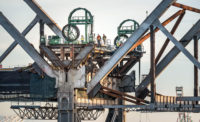Falls also pose a significant hazard. But "we've had zero incidents" involving elevated work, McKinney says.
Workers perform daily job hazard analyses. "It's a very well planned out project," he adds.
Specifications demand that no debris fall into the bay. The team has come within 99.9% of that goal by using custom-designed baskets that surround each steel member to prevent slag from dropping down, along with plywood shields mounted onto 40-ft-long trucks that are pulled up to the edge of the lower deck to act as debris shields, says Howe.
For the Birds
Caltrans recently selected CEC/Silverado as the contractor for the job's $69-million second phase, which includes demolition of five 504-ft-long steel truss spans and 14 288-ft-long spans, along with removal of 13 steel towers.
When work starts later this summer, the team plans to lower each complete span section onto a barge. The strategy minimizes the use of temporary supports in the water and allows the dismantling to occur at a location and a lower elevation so that it can be more easily controlled. That in turn reduces susceptibility to bad weather and eases environmental restrictions. It also allows multiple crews to work on different operations concurrently, Riggs says.
The contractor will have to contend with a rookery of around 1,000 cormorants that occupy part of the truss spans. Nesting season begins in February. If work is not completed by then, the contractor will have to figure out another way to avoid disturbing the birds.
In phase three of the bridge demo, a contractor will remove the underwater pier foundations. Before that contract goes out to bid, Caltrans will first conduct a test implosion on one of the cantilevered span piers using controlled charges. If it works, the method will be used on the other piers.
Once the entire demolition is complete in 2018, crews will have removed a total of 58,209 tons of steel and 245,470 tons of concrete.
Riggs, who will retire once the project is finished, credits careful planning and strong supervision for the surprise-free job. "A balanced team of experienced field people and smart engineering can figure out just about anything," he says.












Post a comment to this article
Report Abusive Comment